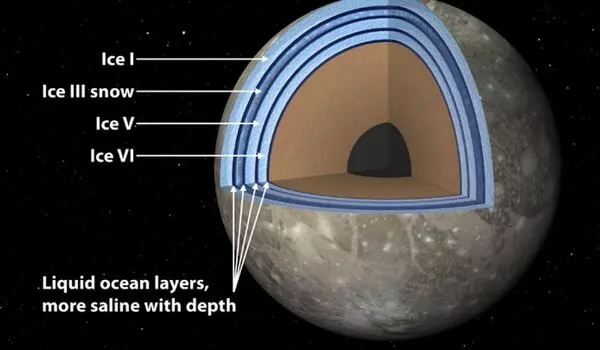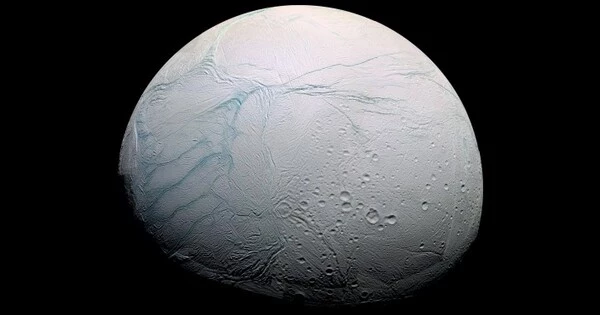Few planets in our solar system are more captivating than Saturn’s icy ocean moon Enceladus. Only a few worlds are known to have liquid water oceans beneath their frozen shells, but Enceladus sprays its ocean into space, where a spacecraft can sample it. Scientists have deduced from these samples that Enceladus contains the majority of the chemical ingredients required for life and most likely has hydrothermal vents spewing hot, mineral-rich water into its ocean.
New research could help scientists determine where to look for signs of life on Saturn’s moon Enceladus in the future. The subsurface ocean of Enceladus, one of Saturn’s moons, appears to be churning with Earth-like currents buried beneath 20 kilometers of ice. The theory, derived from the shape of Enceladus’s ice shell, challenges the current thinking that the moon’s global ocean is homogenous, apart from some vertical mixing driven by the warmth of the moon’s core.
Enceladus, Saturn’s sixth largest moon, is a tiny frozen ball about 500 kilometers in diameter (about one-seventh the diameter of Earth’s moon). Despite its small size, Enceladus drew scientists’ attention in 2014 when a Cassini spacecraft flyby discovered evidence of a large subsurface ocean and sampled water from geyser-like eruptions that occur through fissures in the ice at the south pole. It is one of the few locations in the solar system with liquid water (the other being Jupiter’s moon Europa), making it a target of interest for astrobiologists looking for signs of life.
Knowing the distribution of ice allows us to constrain circulation patterns. This would create a pole-to-equator circulation that influences the distribution of heat and nutrients. Understanding which regions of the subsurface ocean might be the most hospitable to life as we know it could one day inform efforts to search for signs of life.
Ana Lobo
The ocean on Enceladus is almost entirely unlike Earth’s. Earth’s ocean is relatively shallow (an average of 3.6 km deep), covers three-quarters of the planet’s surface, is warmer at the top from the sun’s rays and colder in the depths near the seafloor, and has currents that are affected by wind; Enceladus, meanwhile, appears to have a globe-spanning and completely subsurface ocean that is at least 30 km deep and is cooled at the top near the ice shell and warmed at the bottom by heat from the moon’s core.
Despite their differences, Caltech graduate student Ana Lobo (MS ’17) suggests that oceans on Enceladus have currents akin to those on Earth. The work builds on measurements by Cassini as well as the research of Andrew Thompson, professor of environmental science and engineering, who has been studying the way that ice and water interact to drive ocean mixing around Antarctica.

The oceans of Enceladus and Earth have one thing in common: they are both salty. And, as evidenced by findings published in Nature Geoscience, variations in salinity may drive ocean circulation on Enceladus in the same way that they do in Earth’s Southern Ocean, which surrounds Antarctica. Lobo and Thompson worked on the project with JPL’s Steven Vance and Saikiran Tharimena, which Caltech manages for NASA.
Cassini’s gravity measurements and heat calculations revealed that the ice shell is thinner at the poles than at the equator. Thompson believes that regions of thin ice at the poles are associated with melting and regions of thick ice at the equator with freezing. This has an impact on ocean currents because when salty water freezes, the salts are released, making the surrounding water heavier and causing it to sink. In melt regions, the opposite occurs.
“Knowing the distribution of ice allows us to constrain circulation patterns,” says Lobo. Based on Thompson’s studies of Antarctica, an idealized computer model suggests that the regions of freezing and melting, identified by the ice structure, would be linked by ocean currents. This would create a pole-to-equator circulation that influences the distribution of heat and nutrients.
“Understanding which regions of the subsurface ocean might be the most hospitable to life as we know it could one day inform efforts to search for signs of life,” Thompson says.
Because Enceladus’ ocean feeds the jets, and the jets produce Saturn’s E ring, studying material in the E ring is equivalent to studying Enceladus’ ocean. The E ring is mostly made of ice droplets, but it also contains unusual nanograins of silica, which can only be formed when liquid water and rock interact at temperatures above about 200 degrees Fahrenheit (90 degrees Celsius). This, along with other evidence, points to hydrothermal vents deep beneath Enceladus’ icy shell, similar to the hydrothermal vents that dot the Earth’s ocean floor.
With its global ocean, unique chemistry and internal heat, Enceladus has become a promising lead in our search for worlds where life could exist.





